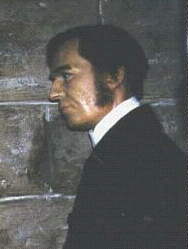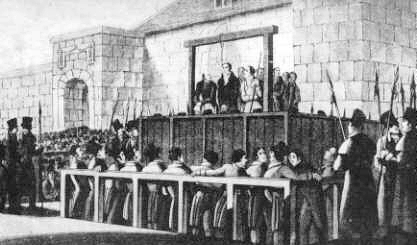|
John
Thurtell - "The Elstree
Murder". |

John Thurtell's case was considered sensational at
the time. It also made history in two significant ways and, therefore, forms a
valuable part of the chronology of capital punishment in
Thurtell was born on
The murder.
Thurtell invited Weare
to spend a weekend gambling with him and some friends at a cottage owned by fellow
gambler, William Probert, at Radlett
in Hertfordshire and they travelled up from
A labourer found the bloody knife and pistol by the cottage and took them to
the authorities and a murder investigation began. As the owner of the cottage, Probert,
was the first to be questioned and realising his predicament turned King's
Evidence against Weare. He also implicated Hunt who
was soon arrested and led the police to the body.
Trial.
Thurtell and Hunt were taken into
custody and came up for trial at the January sitting of the Hertford Assizes
before Mr. Justice Park. Thurtell was charged with
the murder of Weare and Hunt with being an accessory
to it. It was virtually impossible for them to get a fair trial for two
reasons. Firstly, their guilt was seen as self evident by both the press and
the public to the extent that the judge remarked that, “if these statements of
evidence before trial which corrupt the purity of the administration of justice
in its source are not checked, I tremble for the fate of our country." The
newspapers had shown great interest in Thurtell's
case and every detail was lapped up by an eager public. Secondly, this was to
be the last trial in England conducted under the old 16th century principals in
which the accused has to defend himself against the prosecution, being allowed
only to make a speech after the evidence against them had been heard and not
being allowed to cross examine the prosecution witnesses. This was hardly
conducive to a fair trial and neither man was represented by counsel. Thurtell made a lengthy and somewhat rambling address to
the court in which he tried to shift the blame for the killing to Probert. He referred to his Christian upbringing and also
made references, apparently, to Voltaire and Saint Paul, all of which failed to
impress either the judge or the jury. A witness for Thurtell
said, "I always thought him (Thurtell) a
respectable man." Being asked by the judge what he meant by this he
replied, "He kept a gig." Not surprisingly, this was not in itself
enough to save him and it took the jury just 20 minutes to find both accused
guilty. Mr. Justice Park then sentenced them to death and ordered that Thurtell's body be anatomised after execution, as was the
norm at that time for murderers. Hunt's sentence was commuted to transportation
for life and he was duly shipped to Australia's Botany Bay where he was to live
on for very many years. Thurtell was returned to
Hertford prison to await execution. It is noteworthy that even being an
accessory to murder carried the death penalty in the 1820's.
The
new gallows.
Hangings
at Hertford were not a frequent event even then. The previous one having
occurred in August 1822 when Charles Lee was executed there for burglary. It
was thus decided that a new gallows incorporating a proper drop should be built
for Thurtell. This design did away with the need for
ladders and carts to get the prisoner suspended and was copied for several
other prisons round the country, becoming effectively the standard pattern of
its day. A very similar one was used at York Castle from the mid 1820's.
Construction began before the trial, so certain was everybody of the outcome!
Mr. Nicholson, the Under Sheriff of Hertfordshire supervised the work and the
gallows consisted of a "temporary platform with a falling leaf (single
trapdoor) supported by bolts which could be withdrawn in an instant" so
launching the criminal into eternity, as was the contemporary expression. The
substantial cross beam was supported by two equally substantial uprights, about
8 feet high. The enclosure beneath the beam consisted of boards 7 feet high and
dovetailed into each other so that there were no gaps (through which the body
could be viewed). It was 30 feet long and 15 feet deep with a short flight of
steps up to the platform at the back leading directly from the prison door. The
whole gallows was painted black and presented "a very gloomy
appearance." The walls of the
platform rose approximately 2 feet above the platform so the bulk of the
prisoner's body was hidden from view after the drop. The outer enclosure was
for the javelin men who stood guard at hangings to prevent escape or rescue
attempts.
 Execution.
Execution.
James
Foxen, the hangman, arrived from London on the Thursday and made the usual
preparations. Thurtell dressed for the occasion and
was described as being "elegantly attired in a brown great coat with a
black velvet collar, light breeches and gaiters, and a fashionable waistcoat
with gilt buttons." A little before
12 noon on Friday, the 9th of January 1824, Foxen pinioned Thurtell's
hands in front of him with handcuffs (unusual) and he was then led from his
cell to the accompaniment of the tolling prison bell and the prison chaplain
reading the burial service. A few moments earlier he had confessed his guilt to
the chaplain. He mounted the 5 steps slowly but steadily and positioned himself
on the trap. Here Foxen removed his cravat and loosened his collar. When Thurtell had finished praying, Foxen drew the white cotton
cap over his head and placed the noose around his neck. The Governor of Hertford Gaol and the Chief
Warder both shook hands with him before Foxen adjusted the noose.
Postscript.
William
Probert, although escaping prosecution over Weare's murder, was to be convicted of horse stealing the
following year and he was hanged by Foxen on the 20th of June 1825 outside
Newgate with 3 other men.